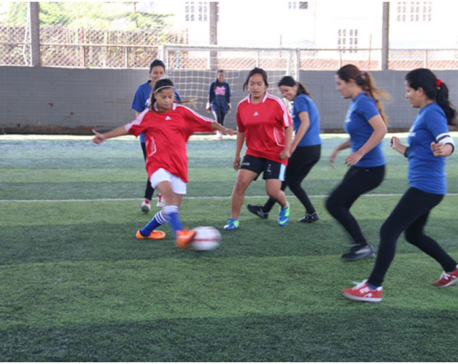
OR

More from Author
We must all stand together to bring the perpetrators of acid attack to justice and to rehabilitate the victims back into the society.
A 22 years old woman recently became a victim of acid attack. A bottle of corrosive substance was poured upon her face. The cause was she refused to be in a relationship with him. The perpetrator was the boss of the factory she used to work in which reflects the ego the boss had that was completely shattered when an ordinary girl rejected him.
Sangita Magar, Samjhana and Sushmita Das, Muskan Khatoon and Pabitra Karki are the tip of the iceberg. Many cases might have gone unreported as we are unfortunate to not have any systematic recording and reporting system for acid violence and are compelled to rely on police records.
In most cases, the only motive of violence is vengeance. Cowards! A jealous, pathetic man who even cannot accuse women of rejection and take such an ill path to satisfy their hunger for revenge and act impulsively like a child? Every time someone gets rejected, should he/she just throw acid?
Acid attack is regarded as a crime of passion and those committing this crime are said to be “fueled by jealousy, vengeance, or madness and provoked by betrayal or disappointment”. But I look at it as the downfall of humanity caused by the insanity of a person disregarding all but the nemesis of a single human as the only goal of life. The most disgusting part is they see women as property.
As per a report by Acid Survivors Trust International (ASTI), 1500 acid attacks are recorded every year all around the world. It is estimated that around 60 percent of acid attacks go unreported every year. News.com.au had published an article in 2017 stating London (456 recorded attacks in 2017) as “the acid capital of the world” though it was Dhaka, Bangladesh where most attacks used to occur. However, in 2020 according to an article by the Quint, India has become the country with the highest number of acid violence in the world and also with the least convictions—of the total perpetrators, only five percent are convicted.
Acid violence is a special form of gender-based violence that knows no gender limits, but the majority of the victims are females—80 percent, according to ASTI. In recent times, acid attacks have grown because of inexpensive and effective access to substances (nitric acid, hydrochloric acid, and sulphuric acid) in countries where toxic violence predominates widely.
The most common reason for attacks on women and girls is the refusal of marriage, the denial of sex, and the sexual rejection of men and boys. The cultural and behavioral environment we are raised in can be attributed as one of the main reasons for acid attacks. Since ages, male dominance has prevailed, they have been regarded as superior to women in both power and status. Thus, perpetrators believe it to be in their power to destroy someone’s life as they please if their ego is not satisfied. Additionally, the high value placed on beauty by the society and the shunning of the grotesque has also somehow influenced the increasing occurrence of attacks.
According to “Acid attack on women: A new face of gender-based violence in India,” an article published in Research Gate, urban areas harbor the majority of these unfortunate events. The migration of people from the rural region to urban brings about a change in their life processes such as the liberty experienced by women which the males find hard to accept and, often, they engage in such crime. Men are also the victims. But women are the ones who are almost always targeted.
The consequences of acid violence are not only physical pain and deformity. The victims must go through immense mental trauma and societal burdens. Physical consequences can range from unendurable pain, possible loss of eyesight, hypertrophic scarring, contractures, and need for reconstructive surgery. The psychological effects are fear of repeat attack, anxiety and depression.
It’s not only the person to blame, the society we live in is not free of flaws. We as a society rarely empathize when such unfortunate events happen. Victims are socially isolated, discriminated, and humiliated most of the time. In countries like Bangladesh, India, and Nepal they have the least opportunity to be employed or getting married. People are frightened to see them. There is a stigma attached to acid victims as many think that girls bring it on themselves.
This deep-rooted stigmatized thinking can be uprooted mostly by education and understanding. Empowering women, securing their rights, and encouraging them to be independent economically can prove to be major steps for rehabilitation as well as reduction of such crimes.
Punishment and awareness is the only way to reduce the number of victims.
The government of Nepal has recently endorsed a law specifying imprisonment for up to 20 years and a fine of up to one million rupees to the perpetrators of acid violence. This is a commendable step.
I want to say to all the victims: We appreciate and regard you for your magnificence and your strength. Your desires and dreams will work out as expected. You will accomplish your objectives and you will never need to see a day of misery or agony in your life. Simply keep persistence. Nothing will stop you.
Kaija Sabbah had once said: “If you consider a woman less pure after you’ve touched her maybe you should take a look at your hands.” Laxmi Agarwal, acid violence survivor, remarked: “He threw acid on my face, not on my dreams.”
Their inner motivation is way more enormous than the perpetrators’ cheap wish to pull them down.
We must all stand together to bring the perpetrators of this heinous crime to justice and to rehabilitate the acid attack victims back into the society.
dipadahal102@gmail.com
You May Like This

Helping women re-envision a better Nepal: Women LEAD Nepal
KATHMANDU,March 7: Women LEAD Nepal started as an idea that women and girls could change the trajectory of Nepal’s future and... Read More...

Combating trafficking
There are no urban centers, in and outside Nepal, where Nepali women and girls may not have been forcibly trafficked Read More...

Futsal for the women, by the women and of the women!
KATHMANDU, March 19: WE United Project launched the Mahila Premier League (MPL) on March 18 at Grassroots Recreational Center in Mandikhatar. ... Read More...





Just In
- CM Kandel requests Finance Minister Pun to put Karnali province in priority in upcoming budget
- Australia reduces TR visa age limit and duration as it implements stricter regulations for foreign students
- Govt aims to surpass Rs 10 trillion GDP mark in next five years
- Govt appoints 77 Liaison Officers for mountain climbing management for spring season
- EC decides to permit public vehicles to operate freely on day of by-election
- Fugitive arrested after 26 years
- Indian Potash Ltd secures contract to bring 30,000 tons of urea within 107 days
- CAN adds four players to squad for T20 series against West Indies 'A'













Leave A Comment